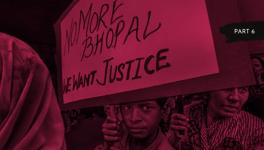COVID-19: Close to 56 Percent of Deceased in Bhopal are Gas Tragedy Survivors

Bhopal: The COVID-19 pandemic is turning out to be more deadly for the victims of the Bhopal gas tragedy – considered to be the world’s worst industrial disaster – than for other patients. Every second death due to the pandemic in the state capital is a victim of the tragedy which occurred between December 2 and 3 in 1984.
Data released by non-governmental organisations (NGOs) working for the rehabilitation of the victims revealed that out of 450 COVID-19-related deaths in Bhopal till October 18, 56% (254) of the deceased were victims of the tragedy that took place 36 years ago.
The COVID-19 death rate among those exposed to methyl isocyanate (MIC) – the gas that leaked that fateful night – is 6.5 times more when compared to those who weren’t. “The pandemic has exposed the official lie that 93% of those exposed to Union Carbide’s poisonous gases had only temporary injuries,” said Rashida Bee, President of the Bhopal Gas Peedit Mahila Stationery Karmchari Sangh.

“We have official records which show that the gas-exposed population, which is 17% of the district’s population of 2.8 million, has contributed to 56% of COVID-19 deaths in the district so far,” she added.
Talking about the risks COVID-19 poses to victims of the tragedy, Dr. Ashok Tiwari of Bhopal Gas Rahat Hospital said: “The majority of the gas victims are suffering from lung infection, cancer, liver infections, hypertension, diabetes and other afflictions and their immunity is weaker than that of a common patient. Hence, they are more prone to the pandemic and fall prey to it.”
However, Subodh Varshney, a surgical gastroenterologist with the Bhopal Memorial Hospital and Research Centre (BMHRC) had a different take on why COVID-19 was affecting the victims more. “Why gas victims are dying from COVID-19 in Bhopal needs to be analysed, but it also has a lot to do with their social-economic condition,” he said.
“In old Bhopal, where people are dying, hygiene is an exception and overcrowding a rule. There are gas victims in new Bhopal, too, but here, it is an open atmosphere. There is not much crowding. Poor hygiene and overcrowding lead to a greater viral load in the atmosphere and residents of such areas become more prone to contracting the infection,” he added.
‘Gas Victims NGOs already Flagged it to Govts, but in Vain’
Sensing the threat that the virus poses to the survivors, given their already poor health condition, the survivors’ associations have already flagged the issue to the state government as well as to the Centre, saying that they were more prone to the disease as they already suffer from respiratory issues and have lung diseases and needed special attention. They dashed off the letters to the Chief Minister, Prime Minister and the Union Health Department and the Bhopal collector in March, but all in vain.
On March 21, a day before the first COVID-19 patient was detected in Bhopal, four activist groups flagged the looming threat of the pandemic on them, pleading for special attention.
“Even after the death of four gas victims due to COVID-19 in Bhopal during April, the State Government and the Health Department didn’t start screening gas survivors. All of them tested positive for COVID-19 following their deaths.” said Rachna Dhingra, an activist with the Bhopal Group for Information and Action (BGIA).
She added that the BMHRC, run by the Indian Council of Medical Research (ICMR) and the Bhopal-based National Institute for Research in Environmental Health (NIREH), has a list of gas victims who are suffering from diseases like chronic obstructive pulmonary disorder (COPD), kidney ailments, lung infection, cancer and diabetes, which render them highly vulnerable to the infection and that no special screening has been carried out for the victims.
“They should have reached out to such gas victims and screened them but nobody cared to do that. In fact, when the district administration initially took over the BMHRC they began to turn the gas survivors away,” she said. The hospital was built solely for treating patients who had suffered as a result of the gas leak.
NGOs Demanded Compensation
During a press conference on November 24, the NGOs demanded extra compensation from the Government as well as Dow Chemical Company.
“The injuries caused by exposure to Methyl Isocyanate are permanent in nature, yet more than 90% of the exposed people have been paid only 500 US dollars compensation for temporary injuries. It is a pity that it took a global pandemic to highlight the injustice meted to the victims of the world’s worst industrial disaster,” said Nausheen Khan of Children Against Dow Carbide.
“Dow Chemical has used the pandemic to cut thousands of jobs and make more profit by producing hand sanitisers, but it looks the other way when the pandemic exposes the lasting damage its subsidiary caused in Bhopal. Dow Chemical continues to evade the pending civil, criminal and environmental liabilities of Union Carbide in Bhopal,” she added.
Get the latest reports & analysis with people's perspective on Protests, movements & deep analytical videos, discussions of the current affairs in your Telegram app. Subscribe to NewsClick's Telegram channel & get Real-Time updates on stories, as they get published on our website.
























